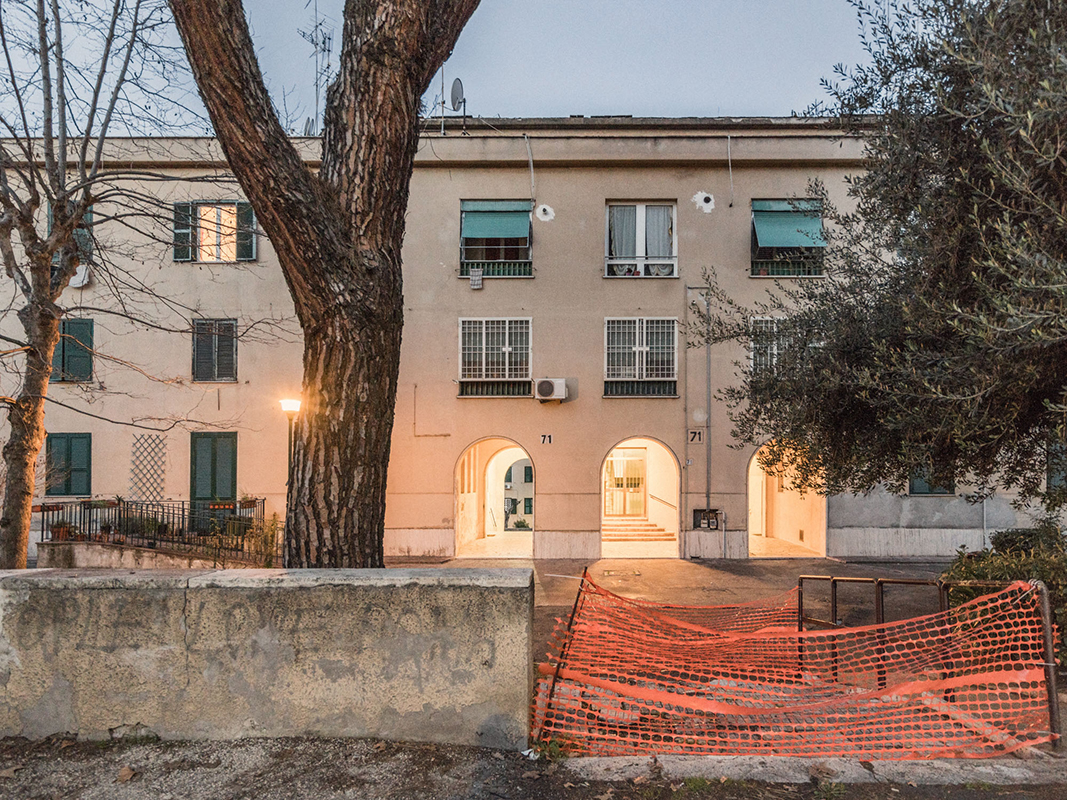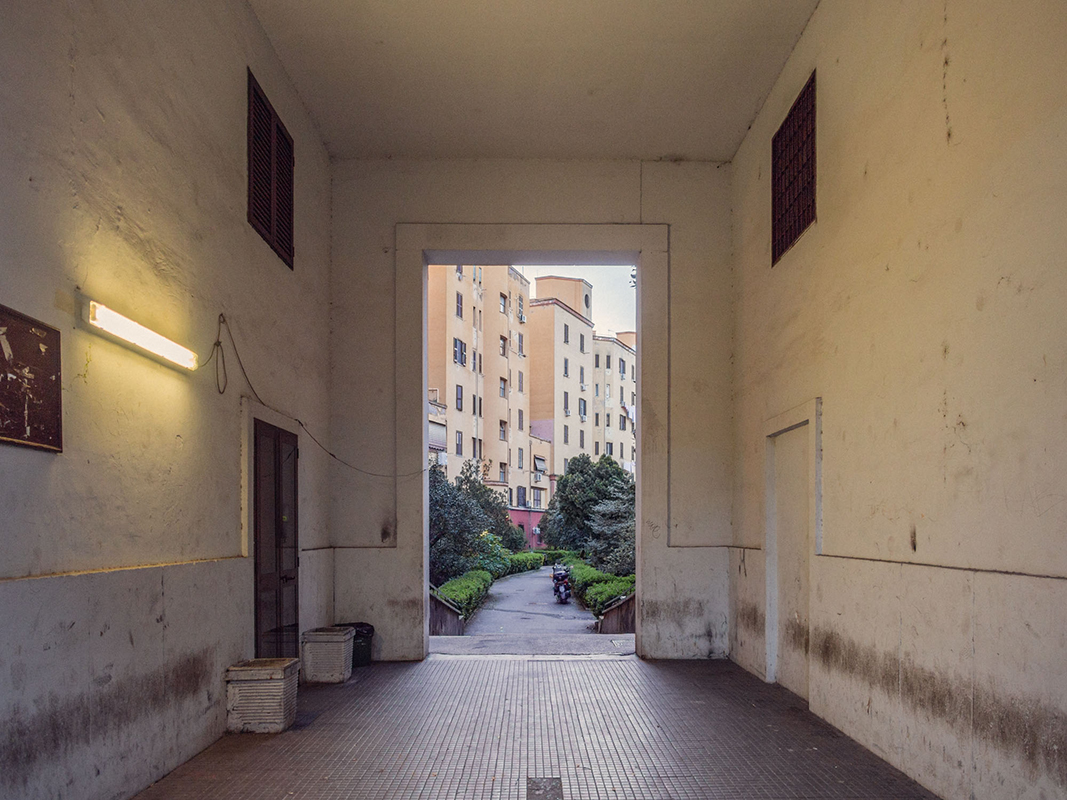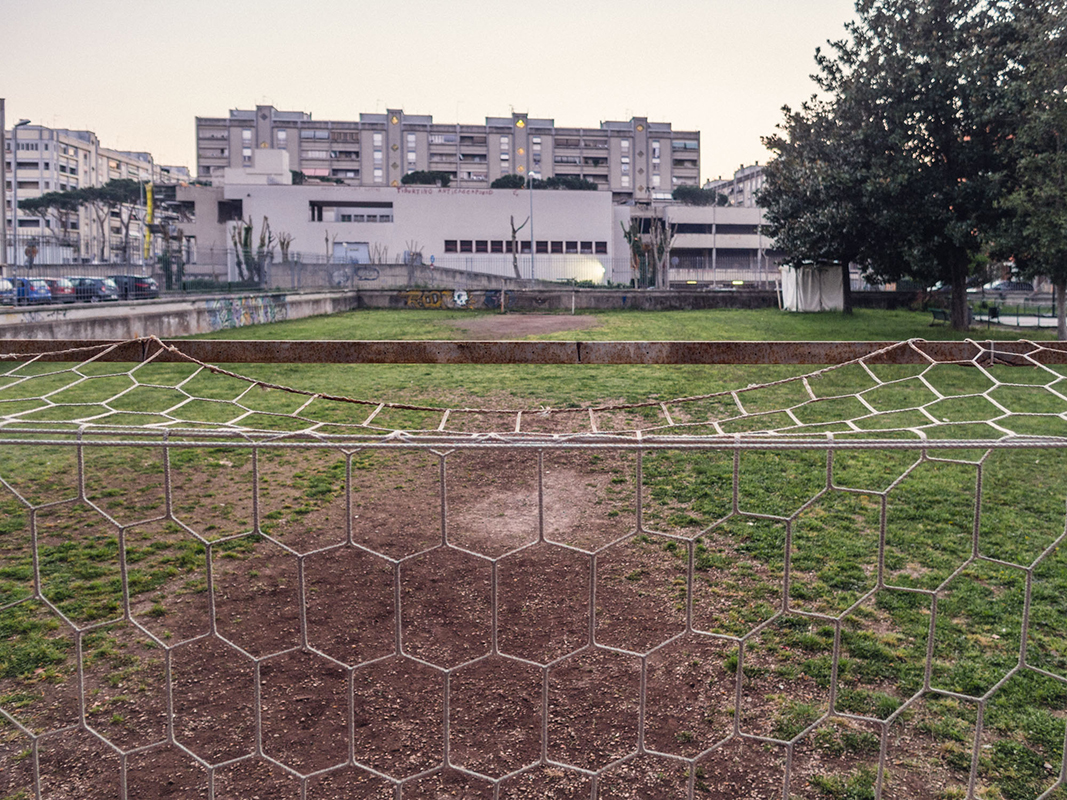Il mio viaggio nelle borgate nasce dal desiderio di esplorare una Roma autentica, non appariscente.
Nel muovere i primi passi, mi sono ispirato a un espediente linguistico condotto sul sostantivo borgate. Immaginandolo composto col suffisso –gate, l’ho dissociato dall’accezione comunemente scandalistica (come, appunto, in Watergate) per avvicinarlo al significato tradotto in “porta, varco”, meglio ancora in “uscita” fotografica nella parte più viva della città.

Pasquale Liguori, Acilia (dalla serie “Borgate”).
(cliccare sull’immagine per consultare la galleria fotografica)

Ho sempre amato inoltrarmi nella periferia. Di quella napoletana, dove mi sono formato, ne serbo il valore, l’identità e l’insegnamento di vita in situazioni anche critiche.
Ammiro la periferia per la sua capacità di “frontiera”, capacità di adattamento, cambiamento e proposta. La amo quando è capace di prendersi cura di sé. Soprattutto, quando si oppone all’incuria e resiste al disinteresse generale.
Le indagini urbanistiche più recenti e rilevanti configurano Roma come città-territorio, estesa su un’area molto vasta e molto articolata al suo interno, dove le persone vivono senza riferirsi solitamente al centro consolidato. È improponibile infatti l’accezione di periferia riferendola alla sua separazione fisica dal centro cittadino formale in un contesto figlio del blob edilizio e di pianificazioni inefficaci o disattese cui la città è stata sottoposta nel corso degli ultimi decenni.
In tale complessità, l’interesse dell’indagine fotografica è caduto sui luoghi dove il regime fascista istituì le cosiddette borgate “ufficiali”, progettate quali entità separate, volutamente distanti dal centro tradizionale e che oggi risultano invece aree costitutive della città.
Tullio De Mauro in più occasioni sottolineava il significato negativo che la popolazione romana, compresi gli abitanti delle borgate, associava al termine borgata. Questo perché largamente legato alle condizioni di vita precarie dell’epoca, ma anche per il significato conferito alla parola che indicava l’abitante della borgata: il borgataro.
I dolorosi e spesso scandalosi aspetti storici, politici, organizzativi alla base della nascita delle borgate sono tuttora oggetto di ricostruzioni e studi approfonditi da parte degli esperti. Ma, intanto, quei luoghi, dopo le tante trasformazioni subite, sono ora pezzi importanti di Roma.
Eppure, nel viaggio che ho effettuato, ho continuamente colto lo spirito geneticamente informale di questi luoghi pur se adesso inglobati nel denso tessuto urbanizzato.
Il contatto fisico con la borgata ha significato lunghi sopralluoghi, parlare con chi ci vive, constatare il livello di multiculturalismo e di servizi, percorrerla nelle sue strade, attraversarla nei condomini, scrutarla nel rapporto con gli spazi circostanti, osservarla nei suoi spazi e nei suoi tempi.

Pasquale Liguori, Pietralata (dalla serie “Borgate”).
(cliccare sull’immagine per consultare la galleria fotografica)


Ho scelto quindi un criterio di ripresa in cui si condensassero gli elementi decisivi per la progettualità di indagine: raccontare dimensioni e strutture della borgata contemporanea, registrando nello stesso momento l’umanità che sottende.
Per questo, avevo bisogno di un momento particolare, in un giorno specifico, dove la densità umana fosse la più elevata possibile. Con edifici pieni di vite da una parte e, dall’altra, piazze e strade praticamente deserte.
Spero di esser riuscito a evitare la trappola della curiosità fine a se stessa, pettegola e grottesca, che porta dritto a rese languide e retoriche della periferia coi suoi problemi. Il degrado è sì ritratto e anche senza sconti, ma non è l’elemento centrale del racconto: nel mirino sentivo arrivare distinta l’energia espressa dalle opportunità.
La domenica invernale, alle prime luci, è un momento di ristoro collettivo. Ed è poi il momento di massima presenza abitativa di quasi tutti gli abitanti della borgata stessa (anche chi appena rientrato dalla notturna visceralità del sabato).
Una fase intermedia tra sonno, recupero almeno parziale da stanchezze e tensioni, risveglio e ferite leccate e, se possibile, la predisposizione più indulgente a riesaminare i luoghi e il contesto in cui si vive. Avendo attenzione per se stessi, in fin dei conti.
Nel momento di questi scatti, gli antagonismi, i conflitti, i dolori e i razzismi risultano sfocati, persino neutralizzati. Predomina la dignità dei singoli e possibilmente quella collettiva, in un modello abitativo che permane certamente complesso.
Nello stesso momento, geometrie, spazi della convivenza visibili nella loro essenziale nudità, sembrano chiedere una parte di beneficio dalla potente carica energetica e affettiva di quei momenti prima che ritorni a dissiparsi sfilacciata nel ritmo della competizione neoliberista del vivere o sopravvivere.
Esiste e si è avvertita un’identità ancora salda, confluente in una somma di esperienze da non disperdere e che può proteggere persino dalle tentazioni fagocitarie della gentrification che ha snaturato altre, vicine periferie.
Le fotografie qui raccolte sono tratte da una più ampia ricerca che continua a essere effettuata sul territorio e, se possibile, costituiscono un tributo a chi vive i luoghi ritratti e, al tempo stesso, un invito a non dimenticare e alla proposta. Alla cura di un valore comune.
Introduction to “Borgate”
My journey through the borgate (suburbs) comes from my desire to explore a more authentic, less notorious, version of Rome.
When I started this project, I took inspiration from a linguistic expedient that could be applied to the term “borgate”. While first imagining it as composed by the English suffix –gate, widely used to refer to political scandals and controversies (by analogy with the “Watergate” scandal), I later associated it to the term “gate” in its literal meaning, to signify the entrance, both metaphorical and physical, to the most vivid sections of the city.

Pasquale Liguori, Tor Marancia (dalla serie “Borgate”).
(cliccare sull’immagine per consultare la galleria fotografica)


I’ve always enjoyed venturing into the suburbs. I carry the suburban Naples, where I grew up, with me to this day, with its values, its strong identity and its life teachings that are still precious in sometimes critical situations.
I’ve always had a deep admiration for the suburbs, for their borderline abilities, their capacity to adapt, change and promote change. I admire the suburbs when they succeed in taking care of themselves. Above all, when they stand against neglect and fiercely oppose general indifference.
The most recent urban surveys and studies have defined Rome as a metropolitan area, spread on a very large and articulated territory, where people live without a direct connection with the city centre. It would be otherwise impossible to define a suburban area just by its physical distance from the city centre in these last decades of urban speculation and inefficient planning.
Given such complexity, the focus of my photographic exploration shifted to the places where the fascist regime had established the “official” residential districts, purposely designed to be located far from the centre of Rome, but which have been gradually absorbed during the urban expansion and are now integral and fundamental parts of the city.
Tullio De Mauro, in more than one occasion, has underlined the pejorative meaning that the roman population has traditionally assigned to the term borgata and to the term referring to the inhabitants of such areas, borgatari; and this is mostly due to the unstable and poor living conditions of the people that first settled in those suburbs.
The painful, and often scandalous, historical, political and administrative aspects that are behind the birth of the suburbs are still debated and objects or research, but these places and their numerous transformations have turned, over the years, into pivotal pieces of Rome.
Nonetheless, as I could constantly notice during my journey, the suburbs still retain their primordial, genetically informal spirit, despite being now profoundly absorbed in the dense urban fabric.
Getting physically in touch with the suburbs meant visiting for long hours, talking to the inhabitants, assessing the quality of the infrastructures and the level of multiculturalism, exploring the blocks while studying their relationship with the surrounding areas; it ultimately meant observing them in their own spaces and times.
I decided, then, for an angle which could enhance the crucial aspects of my research: I wanted to capture both the structural dimension of the contemporary suburbs and the humanity that lies underneath it.

Pasquale Liguori, Val Melaina (dalla serie “Borgate”).
(cliccare sull’immagine per consultare la galleria fotografica)
That is why I needed a specific time of the day in which the housing density could be at its highest: I needed buildings crawling with life on one hand, and empty and deserted streets and squares on the other.
I’m hoping I managed to escape the common traps of the voyeuristic curiosity, always misleading and grotesque, that often leads to a rhetorical and languid portrait of the suburbs and their issues.
Yes, the environmental degradation is here told with no sugar coating on it, but it is not intended as the core of my story: my viewfinder was rather pointed at the powerful energy that distinctively flows from opportunity.
At the break of dawn, wintery Sundays are a time of collective rest. They are also the moment in which the indoor population is at its highest and most of the inhabitants are in their homes (including those recovering from their Saturday night fever). An intermediate phase made of sleep, attempts to recover from fatigue and stress, slow awakenings and wound licking; at times, these moments can also be an indulgent occasion to reassess the places and contexts in which one lives.
In my snapshots, the antagonisms and the racisms, the conflicts and the struggles seem to show out of focus, almost neutralised. Instead, what is predominant is the dignity, both individual and collective, that can still be found in these definitely complex housing arrangements.
At the same time, the naked geometry of cohabitation seems to be wanting to enjoy those resting moments’ emotional energy before it dissipates again into the neo-liberalist rhythm of the competition between living and surviving.
These places still own a very strong, perceivable identity flown into a sum of experiences worth preserving; an identity that can even protect those places from the devouring instances of that gentrification that has already deprived numerous neighbouring districts of their very nature.
These pictures, my pictures, constitute only a section of an ongoing, larger research project on the suburbs which is to be intended both as a tribute to those who live the suburbs and, where possibile, as an invitation to memory and proactive attitudes. An invitation to treasure our common values.









